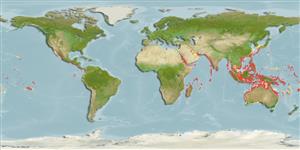Common names from other countries
>
Eupercaria/misc (Various families in series Eupercaria) >
Labridae (Wrasses) > Corinae
Etymology: Halichoeres: Greek, als, alis = salt + Greek, choiros = pig (Ref. 45335).
More on author: Bennett.
Environment: milieu / climate zone / depth range / distribution range
Ecologia
marinhas associadas(os) a recifes; intervalo de profundidade 10 - 40 m (Ref. 90102). Tropical
Indo-West Pacific: Persian Gulf (Ref.80050); Red Sea and the Gulf to Samoa, north to southern Japan, south to the Great Barrier Reef (Ref. 9710). Western Indian Ocean: Mozambique (Ref. 41878).
Tamanho / Peso / Idade
Maturity: Lm ? range ? - ? cm
Max length : 20.0 cm TL macho/indeterminado; (Ref. 9710)
Descrição breve
Chaves de identificação | Morfologia | Morfometria
Espinhos dorsais (total) : 9; Raios dorsais moles (total) : 11; Espinhos anais: 3; Raios anais moles: 11. Females light bluish gray dorsally, white ventrally, with a narrow orange stripe running from the top of the snout to the upper base of the caudal fin (where it may contain a blackish spot). Males blue-green on head and anterior portions of the body with irregular pink band and spots; their orange-yellow lateral stripe blue-edged, often with narrow extensions; a blue-edged spot at the upper portion of the pectoral fin base, and two or more similar blue-edged spots just anterior of the caudal peduncle above the lateral stripe.
Inhabits open sand and rubble areas of seaward reefs, to depths greater than 34 m (Ref. 9710). Usually in small groups of females with single males patrolling the area (Ref. 48636).
Life cycle and mating behavior
Maturities | Reprodução | Spawnings | Egg(s) | Fecundities | Larvas
Distinct pairing during breeding (Ref. 205).
Randall, J.E., G.R. Allen and R.C. Steene, 1990. Fishes of the Great Barrier Reef and Coral Sea. University of Hawaii Press, Honolulu, Hawaii. 506 p. (Ref. 2334)
Categoria na Lista Vermelha da IUCN (Ref. 130435)
CITES (Ref. 128078)
Not Evaluated
Ameaça para o homem
Harmless
Utilização humana
Pescarias: espécies comerciais; Aquário: Espécies comerciais
Ferramentas
Relatórios especiais
Descarregue XML
Fontes da internet
Estimates based on models
Preferred temperature (Ref.
115969): 24.6 - 29.1, mean 27.9 (based on 750 cells).
Phylogenetic diversity index (Ref.
82804): PD
50 = 0.5000 [Uniqueness, from 0.5 = low to 2.0 = high].
Bayesian length-weight: a=0.00977 (0.00563 - 0.01695), b=3.15 (3.00 - 3.30), in cm Total Length, based on LWR estimates for this species & Genus-body shape (Ref.
93245).
Nível Trófico (Ref.
69278): 3.5 ±0.5 se; based on size and trophs of closest relatives
Resiliência (Ref.
120179): Médio, tempo mínimo de duplicação da população 1,4 - 4,4 anos (Preliminary K or Fecundity.).
Fishing Vulnerability (Ref.
59153): Low vulnerability (10 of 100).
